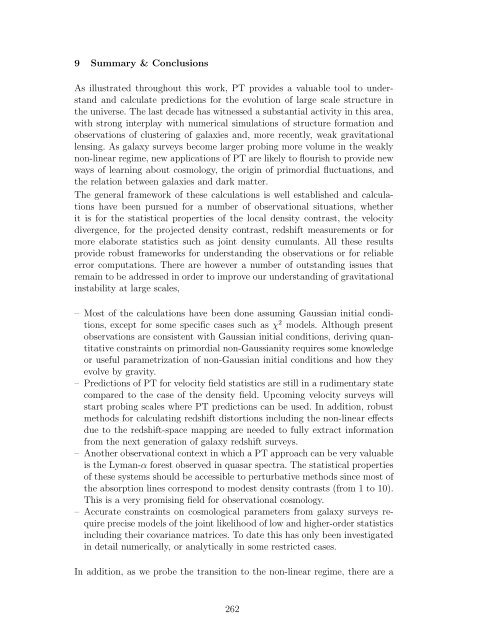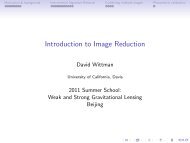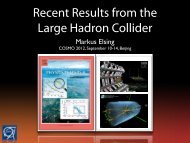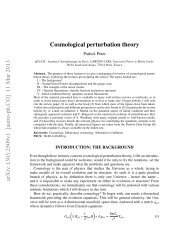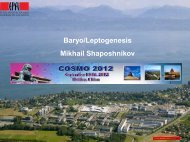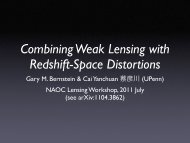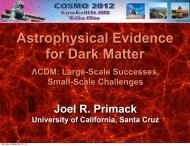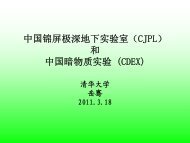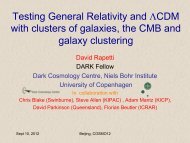Large-Scale Structure of the Universe and Cosmological ...
Large-Scale Structure of the Universe and Cosmological ...
Large-Scale Structure of the Universe and Cosmological ...
Create successful ePaper yourself
Turn your PDF publications into a flip-book with our unique Google optimized e-Paper software.
9 Summary & Conclusions<br />
As illustrated throughout this work, PT provides a valuable tool to underst<strong>and</strong><br />
<strong>and</strong> calculate predictions for <strong>the</strong> evolution <strong>of</strong> large scale structure in<br />
<strong>the</strong> universe. The last decade has witnessed a substantial activity in this area,<br />
with strong interplay with numerical simulations <strong>of</strong> structure formation <strong>and</strong><br />
observations <strong>of</strong> clustering <strong>of</strong> galaxies <strong>and</strong>, more recently, weak gravitational<br />
lensing. As galaxy surveys become larger probing more volume in <strong>the</strong> weakly<br />
non-linear regime, new applications <strong>of</strong> PT are likely to flourish to provide new<br />
ways <strong>of</strong> learning about cosmology, <strong>the</strong> origin <strong>of</strong> primordial fluctuations, <strong>and</strong><br />
<strong>the</strong> relation between galaxies <strong>and</strong> dark matter.<br />
The general framework <strong>of</strong> <strong>the</strong>se calculations is well established <strong>and</strong> calculations<br />
have been pursued for a number <strong>of</strong> observational situations, whe<strong>the</strong>r<br />
it is for <strong>the</strong> statistical properties <strong>of</strong> <strong>the</strong> local density contrast, <strong>the</strong> velocity<br />
divergence, for <strong>the</strong> projected density contrast, redshift measurements or for<br />
more elaborate statistics such as joint density cumulants. All <strong>the</strong>se results<br />
provide robust frameworks for underst<strong>and</strong>ing <strong>the</strong> observations or for reliable<br />
error computations. There are however a number <strong>of</strong> outst<strong>and</strong>ing issues that<br />
remain to be addressed in order to improve our underst<strong>and</strong>ing <strong>of</strong> gravitational<br />
instability at large scales,<br />
– Most <strong>of</strong> <strong>the</strong> calculations have been done assuming Gaussian initial conditions,<br />
except for some specific cases such as χ 2 models. Although present<br />
observations are consistent with Gaussian initial conditions, deriving quantitative<br />
constraints on primordial non-Gaussianity requires some knowledge<br />
or useful parametrization <strong>of</strong> non-Gaussian initial conditions <strong>and</strong> how <strong>the</strong>y<br />
evolve by gravity.<br />
– Predictions <strong>of</strong> PT for velocity field statistics are still in a rudimentary state<br />
compared to <strong>the</strong> case <strong>of</strong> <strong>the</strong> density field. Upcoming velocity surveys will<br />
start probing scales where PT predictions can be used. In addition, robust<br />
methods for calculating redshift distortions including <strong>the</strong> non-linear effects<br />
due to <strong>the</strong> redshift-space mapping are needed to fully extract information<br />
from <strong>the</strong> next generation <strong>of</strong> galaxy redshift surveys.<br />
– Ano<strong>the</strong>r observational context in which a PT approach can be very valuable<br />
is <strong>the</strong> Lyman-α forest observed in quasar spectra. The statistical properties<br />
<strong>of</strong> <strong>the</strong>se systems should be accessible to perturbative methods since most <strong>of</strong><br />
<strong>the</strong> absorption lines correspond to modest density contrasts (from 1 to 10).<br />
This is a very promising field for observational cosmology.<br />
– Accurate constraints on cosmological parameters from galaxy surveys require<br />
precise models <strong>of</strong> <strong>the</strong> joint likelihood <strong>of</strong> low <strong>and</strong> higher-order statistics<br />
including <strong>the</strong>ir covariance matrices. To date this has only been investigated<br />
in detail numerically, or analytically in some restricted cases.<br />
In addition, as we probe <strong>the</strong> transition to <strong>the</strong> non-linear regime, <strong>the</strong>re are a<br />
262


